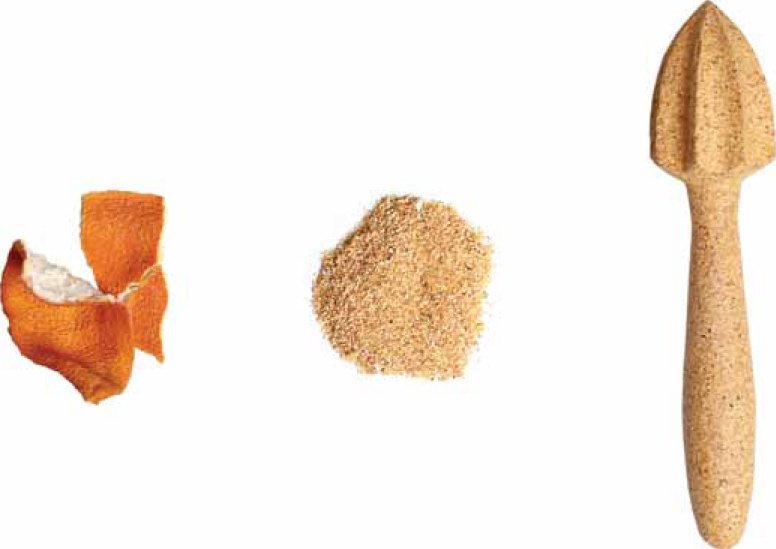This by-product of the fruit juice industry is a renewable and compostable material. As many other case studies in this book have demonstrated, designers are turning uncommon waste and biomaterials into manufacturable new forms using design creativity and experimentation to produce new recipes for materials from natural ingredients. Suzanne Lee is one such example with her BioCouture projects, and APeel – by Alkesh Parmar – is another.
Parmar has taken the rind, pith and seed waste from the orange juice industry and transformed it into a viable mouldable, rigid material. And a huge amount of waste it is: according to the Food And Agriculture Organization of the United Nations, Brazil accounts for the largest production of oranges in the world. In 2011 its total production was in the region of 19,000,000 tonnes and, if we estimate that around a third is used for processing – then that’s about 95,000,000,000 tonnes of waste from Brazil alone.
APeel is a 100% sustainable material that uses only natural, organic binders – no resins and synthetic binders have been added. Is also conceived to create a material that uses the least amount of water, energy and economical manufacturing methods. Hard or flexible, depending on the exact type of ingredients, APeel uses the dried rind as the particles that give the material its course texture, and pectin, found in the rind, as a binder. In case you are wondering, it does have a citrus fragrance, but only when you give it a gentle rub.
Image: APeel by Alkesh Parmar

Key features
•High strength
•Good thermal conductor
•Good sound absorption properties
•Compostable
•High density
•Odour neutralizing
•Watertight for limited periods of time
Oranges are grown in tropical and subtropical climates, with Brazil being by far the largest producer. APeel also has the potential to become a ‘local’ material in the hot climates that can sustain orange growth.
Cost
It is difficult to give precise costs, but when compared with cardtype materials it can be cheaper. And apart from being a sustainable alternative to MDF it also offers a comparable cost.
Sustainability issues
According to Alkesh there is around 15.6 million metric tonnes of citrus waste per year that can be converted into a new material. Where the use of food crops as the source for materials is often berated for removing a source of food, APeel uses only the by-product, which ordinarily has no use. As a fruit, oranges are seasonal and therefore create a challenge for year round supply.
Production
APeel can be compression moulded, cast, extruded and – if formed in a sheet – can be laser cut and machined on standard woodworking machines. Alkesh is also currently exploring the idea of rapid 3D printing with the material.
Typical applications
Alkesh is currently proposing APeel as an alternative to MDF for the construction industry and as a material for prototyping. Other applications include heels for footwear, to replace polyurethane, and as insoles as a natural odour neutralizer. In addition, it is being considered for cosmetic packaging, plant pots, egg cartons and fruit trays for packaging.
| + | – |
|
–Versatile production –Uses up waste from the food industry –100% sustainable |
–Year-round supply is a challenge. |
